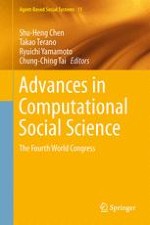
2014 | OriginalPaper | Buchkapitel
16. A Computational Study of Rule Learning in “Do-It-Yourself Lottery” with Aggregate Information
verfasst von : Takashi Yamada, Takao Terano
Erschienen in: Advances in Computational Social Science
Verlag: Springer Japan
Aktivieren Sie unsere intelligente Suche, um passende Fachinhalte oder Patente zu finden.
Wählen Sie Textabschnitte aus um mit Künstlicher Intelligenz passenden Patente zu finden. powered by
Markieren Sie Textabschnitte, um KI-gestützt weitere passende Inhalte zu finden. powered by